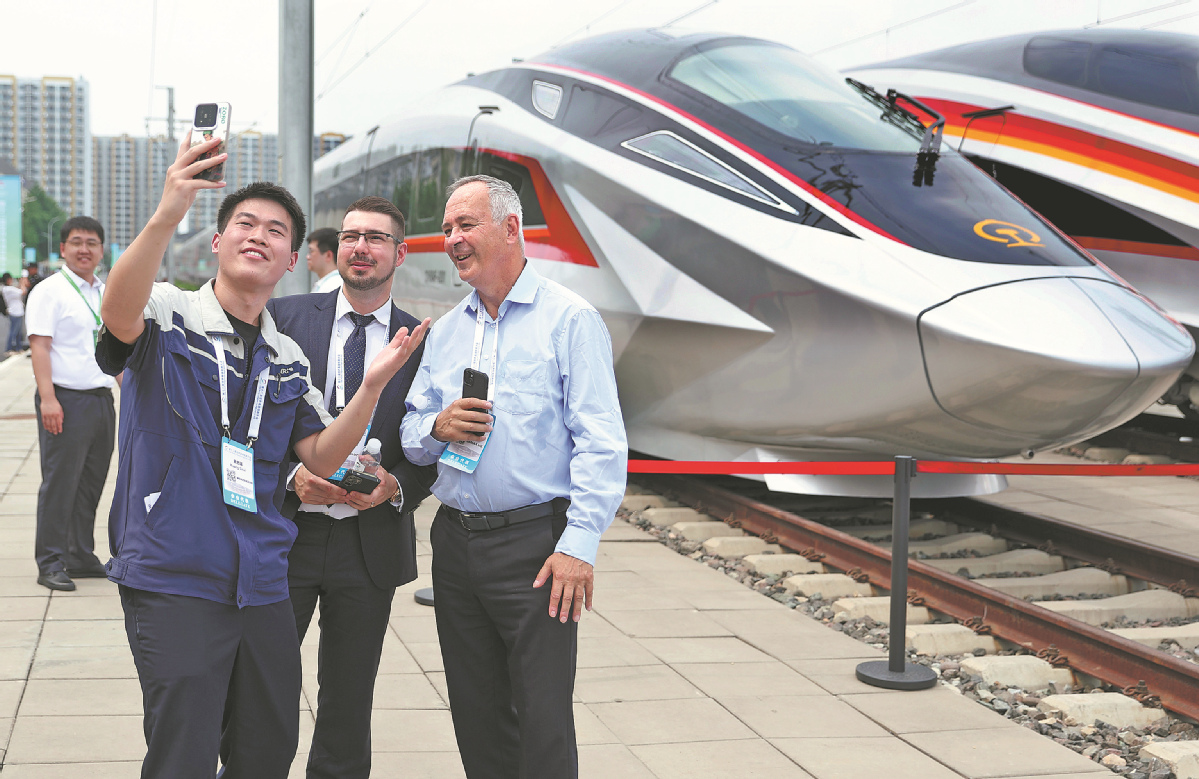Nation's high-speed rail 'a source of inspiration'
Faster, greener transport seen as part of climate solution push


As the world confronts the growing urgency of climate change, a centuries-old innovation is offering a distinctly modern solution.
High-speed rail, once praised mainly for its expediency and convenience, is now seen as a vital tool in reducing emissions. And leading that transformation, both in scale and ambition, is China.
Railway industry leaders have underscored that message this week at the 12th World Congress on High-Speed Rail in Beijing, a flagship event co-hosted by China State Railway Group and the International Union of Railways. The gathering, which runs through Friday, features technical forums, roundtable discussions and an international railway technology exhibition.
From speed to solution
"High-speed rail is one of the most powerful tools we have to reduce transport emissions," said Alan Beroud, chairman of the International Union of Railways, known as UIC by its French abbreviation. "It produces up to 90 percent less carbon dioxide than air travel and can help shift millions of passengers from road and air to rail."
In the context of global climate goals, he added, "this is a huge opportunity. If countries are serious about meeting their Paris Agreement targets, high-speed rail must be part of the solution."
The world's high-speed rail network now spans 65,000 kilometers across 22 countries, according to UIC data. Thousands of bullet trains operate daily, linking cities, cutting travel times, and supporting regional and social development.
The roots of this transportation revolution stretch back nearly 200 years to Sept 27, 1825, when Locomotive No 1 became the world's first steam locomotive to carry passengers on a public railway in England, traveling at 24 kilometers per hour.
Since then, rail has evolved from a mechanical marvel into what advocates say is a climate savior.
In the past, high-speed rail was mostly about getting people from city to city faster, said Bertrand Minary, UIC's passenger director and regional coordinator for Latin America and the Middle East.
"But that has changed," he said. "Today, with the growing demand for green mobility and the urgency of climate change, high-speed rail is increasingly seen as one of the most effective tools for a sustainable future. It's faster, greener and smarter."
Minary noted that more countries are shifting their focus toward high-speed rail as a climate necessity.
"I was in Latin America just a few weeks ago," he said. "They want to replace short-haul flights and connect cities through low-carbon infrastructure. That simply wasn't the case before."
China's high-speed ascent
Beroud said the global high-speed rail network will continue to expand, with China's experience playing a central role.
"Over the next decade, high-speed rail will continue to expand with dozens of new lines planned and constructed around the world," he said. "China, with over two-thirds of the world's operational high-speed network, is a global leader and a source of inspiration."
In less than two decades, China has built the world's largest high-speed rail system, reshaping mobility and regional development. By the end of last year, China's high-speed network spanned 48,000 km, accounting for more than 70 percent of the global total.
"We've moved from the 'Four Vertical and Four Horizontal 'framework to a more extensive' Eight Vertical and Eight Horizontal' grid and continue to push for high-quality development," said Wang Lixin, vice-president of China State Railway Group.
China's ambitious projects include the 1,318-km Beijing-Shanghai line, which operates at speeds of up to 350 km/h, and the Harbin-Dalian line, which runs through regions with seasonal permafrost and temperature fluctuations exceeding 70 C.
Other projects include the Lanzhou-Urumqi line, crossing more than 1,000 km of Gobi Desert at elevations above 3,600 meters, and the Beijing-Zhangjiakou line, known for its smart rail technologies. The Hainan Island Loop High-Speed Railway in the country's tropical south demonstrates the country's environmental versatility.
China's self-developed Fuxing train family now operates on 17 routes covering over 8,100 km. "They run at the world's highest commercial speed, up to 350 km/h, and are adapted to extreme climates, including snow, desert winds and high altitudes," Wang said.
Beyond physical infrastructure, China has built the world's largest real-time railway ticketing system. The system can process up to 26 million tickets a day, with daily ridership exceeding 16 million, Wang said.
Shared ambition
While leading the way in rail development, China is also sharing its expertise, partnering with more than 40 countries and regions on railway projects, from Southeast Asia to Eastern Europe.
The Jakarta-Bandung high-speed line in Indonesia has cut travel time from more than three hours to 46 minutes. In Southeast Asia, the China-Laos Railway linking Kunming and Vientiane has become a model for cross-border connectivity. In Europe, the Hungary-Serbia Railway represents a milestone in aligning Chinese and European Union rail standards.
Ulan Kulov, deputy general manager of the China-Kyrgyzstan-Uzbekistan Railway Co, said a ride on China's network offered a glimpse into the future.
"Fast, smooth and comfortable," he said of his journey from Nanjing in Jiangsu province to Beijing. "We all acknowledge that China is the undisputed leader in high-speed rail, and its willingness to share that expertise is helping others leap forward."
Daochinda Siharath, managing director of Laos National Railways, called the China-Laos Railway a "historic first" for his country, saying the modern rail system is helping expand the network across the region.
"The development of high-speed rail networks is bringing a better life to the people," said Sommad Pholsena, vice-president of the Lao National Assembly. "We in Laos are ready to work together with China and other countries to achieve this shared goal."
Industry leaders say China's rail model offers lessons for other nations.
"Several concrete takeaways can be drawn from China's high-speed rail experience, both in construction and operation," Beroud said. "Its long-term planning has been essential, and the integration of rail infrastructure into broader national development strategies is a model worth learning from."
Minary echoed the sentiment.
"Every country's rail model may be different, but the idea of bringing together the best technicians to build the smartest product is a shared goal," he said. "At the end of the day, it's all for humanity."
- Former Ningxia political advisor sentenced to death for bribery
- Former senior official of Jiangxi expelled from CPC
- Chongqing doctor saves senior passenger mid-flight
- Former director of national TCM administration transferred for prosecution
- Massive sauropod discovered in Chongqing
- Defense Ministry's account on X to serve as a bridge between China and the world





































